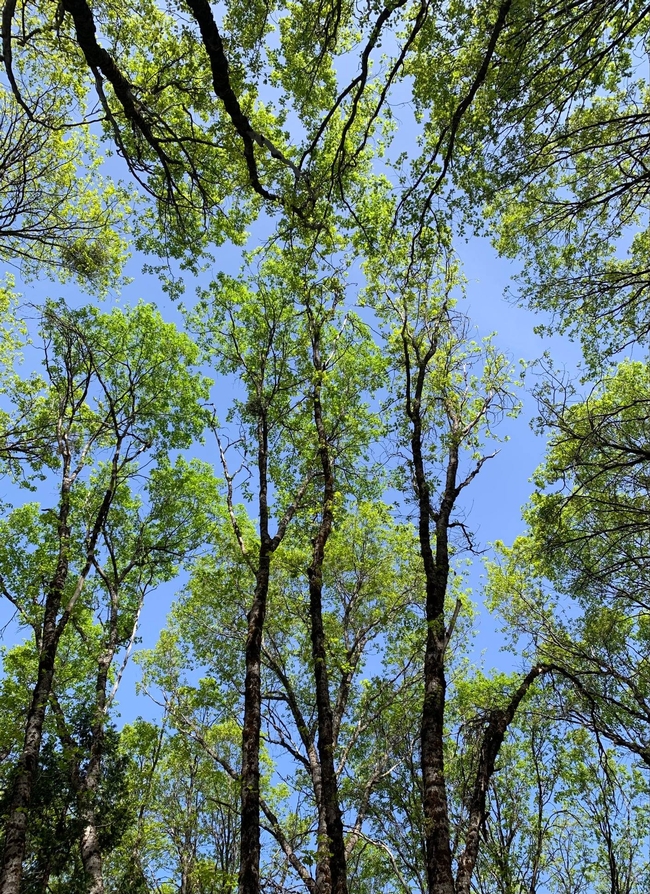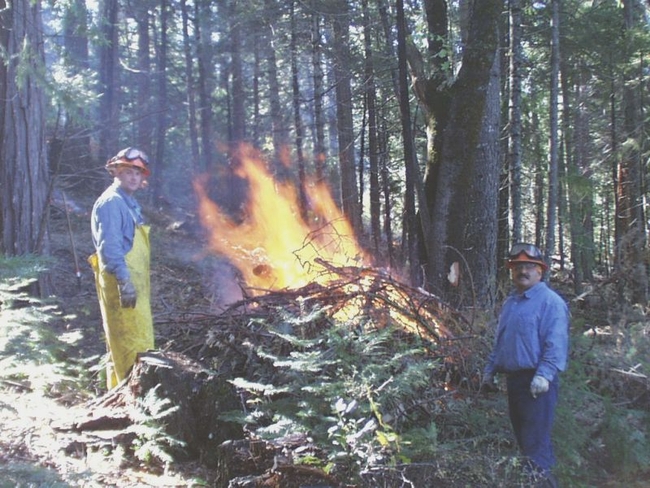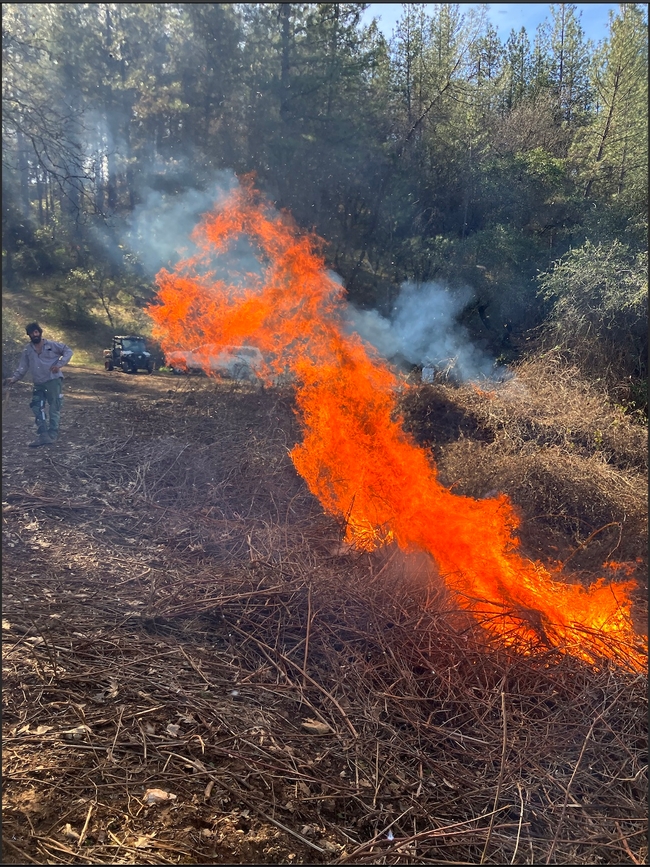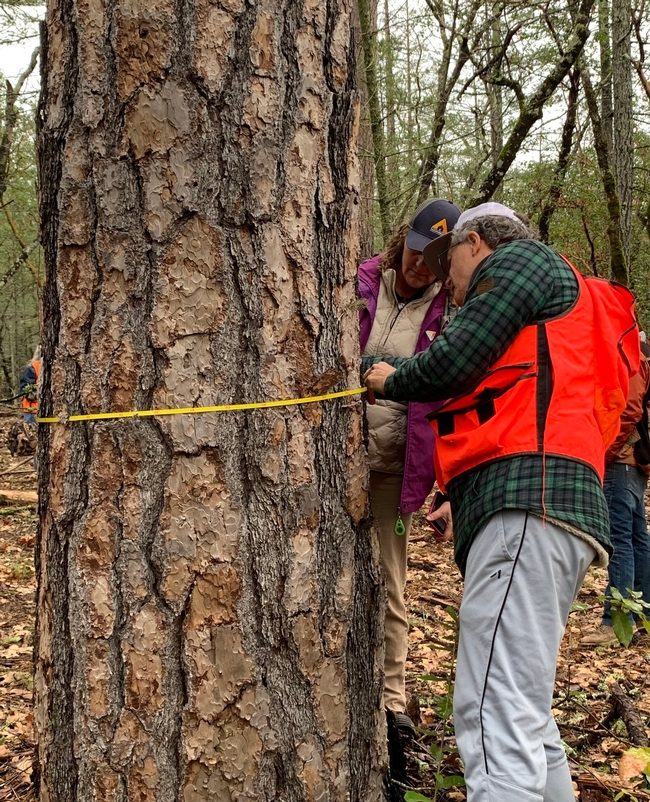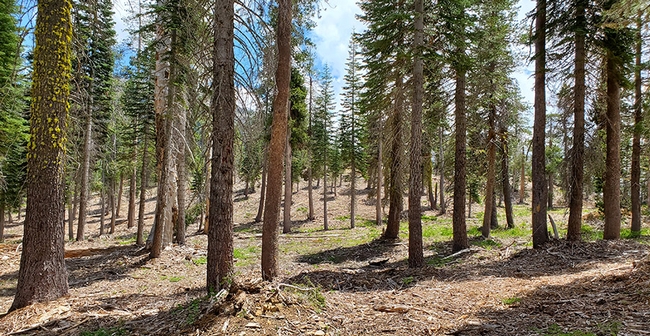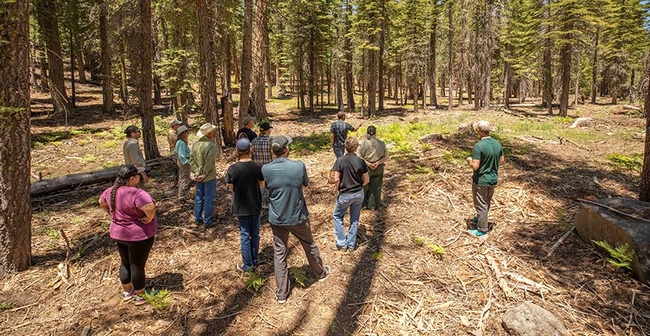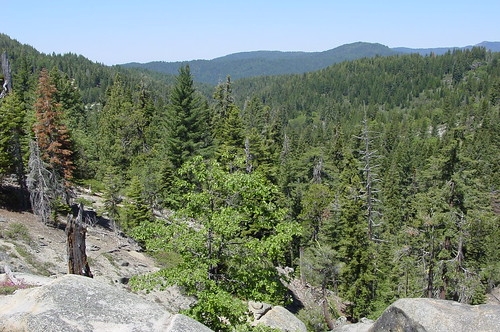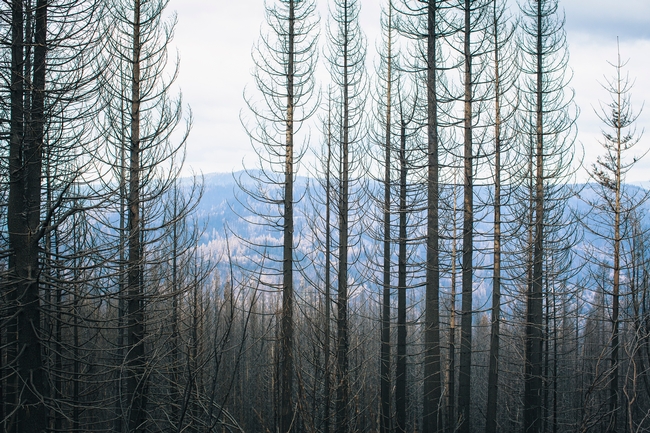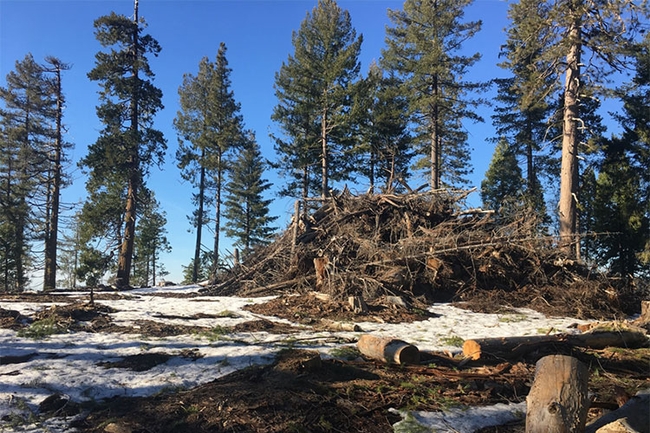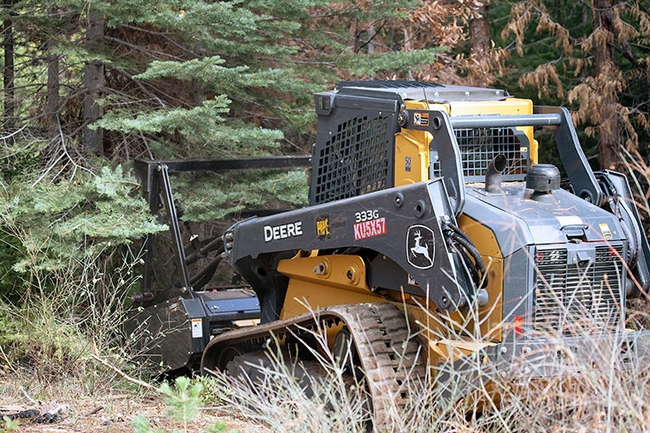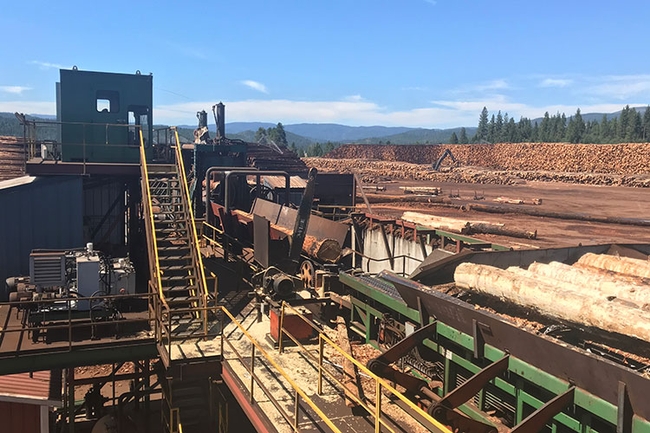Posts Tagged: forest management
Top 10 tools for new forest landowners
Earth Day 2023 celebrates the ways in which we can all invest in our planet, and forest landowners play a considerable role in this. Part of being a forest landowner is deciding where and when to invest your time, money and energy. To assist them, the UC Cooperative Extension Forest Research and Outreach team collaborated with four experienced landowners to highlight 10 tools a first-time forest landowner can invest in.
Listed below, these 10 tools expand past saws and rakes to include tools that educate landowners and support their management activities. We hope this compilation gives readers new to forest management a proper start.
1. Management Goals: Every tool a new forest landowner buys should help advance a management goal. Each of the four interviewees emphasized that understanding what you and your land need is the number-one priority to be investing time and effort into.
“That's my management goal: a healthy forest with as much biology as I can support. Keeping the big trees, letting fire in every once in a while…and correcting the problems we've caused in the past. The species we have here now, it's mostly white fir. People took out the Douglas Fir, the Sugar Pine and you have to do enough thinning to replant those species because they're not coming in that fast underneath the dense fir forest.”
-Brent, Nevada County
2. Pruning and Cross-cut saws: When completing thinning or clearing projects, every forest landowner has their go-to saws. Cross-cut saws are used for cutting down trees, whereas pruning saws cut away dead or diseased branches. Don't forget to look outside of the box for your tools, as one landowner told us about her preference for Japanese tools.
“My Japanese pruning saw… it cuts like butter! It can easily take down trees up to four inches in diameter. The Japanese-made tools, they're smoother and sharper.”
-Danica, Sonoma County
3. A McLeod was cited by each of the four landowners as a must-have tool in every forest landowner's tool kit. One side can be used as a hoe and the other side as a rake, making it useful for activities ranging from trail building to raking in brush for a pile burn.
“For pitching stuff in and raking things out [of a pile burn], you're going to need a McLeod. And if you want to clear a brush pile, it's heavy. And it [the McLeod] works really well for that.”
-Brent, Nevada County
4. Succession or legacy plan: Thinking about who will take care of your land after you is a key aspect of successful forest management. However, bequeathing land to a family member isn't the only option. You could also consider donating your land to a local tribe or to group like the Nature Conservancy.
“[Regarding legacy] On the forest that we manage, we have a conservation easement so it can't be developed. But it doesn't stop it from being logged…How do you conserve? How do you decide? You can let an organization manage it, but it might be in their interest to thin [the forest]. I'll do what I can - I'll set it up for you [the next generation] and hope that there's a shift in the future and we'll learn to steward our resources.”
-Brent, Nevada County
5. Weed Wrench: What to do when you encounter an unwanted plant? When restoring native plants and clearing unwanted invasives, some species are more difficult to uproot than others. If your garden shears aren't cutting it, reach for a weed wrench like the one here.
“I have a lot of bay laurel and there's a lot of saplings that come up and they resprout vigorously. You have to literally pull it out by the root…so I use a weed wrench, and that's been a really valuable tool for me. It's also good for Scotch Broom, anything that has a small diameter neck that you can clamp on to and leverage out.”
-Sacha, Humboldt County
6. Newsletters: Sometimes reading about what other landowners are doing can help you find inspiration for management activities. The Forestland Steward newsletter, which covers general forest management news and events, would be a good place for a new landowner to begin. Additionally, subscribing to newsletters that cater to your region and management goals is a simple way to find applicable management recommendations.
“I subscribe to a bunch of email newsletters, and those are constantly talking about…like, what upcoming events are going on? What are educational conferences going on? I'm constantly getting research articles, casual writings, webinars…For me, I'm personally interested in good fire, so I subscribe to a lot of resources that are focused on using fire as a land management tool.”
-Sacha, Humboldt County
7. Record keeping: Come tax season, you will thank yourself for investing time in keeping records of your management activities. If you find yourself receiving funding in the form of grants, conservation easements or other programs, having a trusted tax advisor or accountant should be a consideration. A close collaborator with the Forest Stewardship Program, Larry Camp, (Registered Professional Forester, forest landowner and retired IRS agent) notes, “Treating your forestland as a business or investment is an important step forward in efficiently managing your forest and can lead to incentives and deductions that will legally reduce your tax burden.”
8. Land History: For many forest landowners, learning about indigenous history is not only fascinating, but a thoughtful reminder of the original caretakers of California forestland. Investigate your land and delve into Traditional Ecological Knowledge (TEK), which may inspire new projects.
“When we're talking about land and access to land, I think it's always good to be thinking about tribal sovereignty, and what are actions we can do to support that. Historically, this [land] was an oak woodland…we're playing catch up over 150 years of fire suppression policies. I'm working towards oak woodland restoration, and part of that is that tie-in to responsibility to tribal access.”
-Sacha, Humboldt County
9. Management education resources: Though we at UCCE have our own Forest Stewardship Workshop series, there are often informational webinars and videos offered through regional organizations. The California Wildfire and Forest Resilience Task Force website has a list of educational resources for landowners, found here.
“I'm big on education, and when you're participating in that educational group, they [program participants] might throw out a different name, or a different agency you can use. It's really about being involved and taking up the suggestions that people give you.”
-Laura, Nevada County
10. Community: Getting connected with organizations like your local Resource Conservation District (RCD), Natural Resources Conservation Service (NRCS), CAL FIRE, or UC Cooperative Extension (UCCE) office can be a big help to new landowners. These organizations house experts such as Registered Professional Foresters (RPFs) who can provide technical assistance and assist in applying for permits or drafting a management plan. Devote time looking into region-specific organizations such as the Foothill Conservancy and My Sierra Woods that service multiple counties. Peer networks are a plus as well. Community ties were continuously cited by the forest landowners we spoke to as being a valuable resource.
“Try to figure out what organizations are around you that are doing stuff. Around here, there's the Mid-Klamath Watershed Council, and they'll have invasive plant removal days, and you can go and volunteer. Doing something like that, where you're hands-on and connecting with other people is what I'd suggest.”
-Sacha, Humboldt County
“My community…is definitely close knit, because it's tough! It's a lot of work. And, you know, if I'm renting a chipper and it's up at my property and someone else wants to use it, they can. It's very, very helpful to be close with your neighbors and learn from them.”
-Laura, Nevada County
Study shows how restoring California's overstocked forests yields multiple, diverse benefits
Mechanical thinning of overstocked forests, prescribed burning and managed wildfire now being carried out to enhance fire protection of California's forests provide many benefits, or ecosystem services, that people depend on.
In a paper published in Restoration Ecology, researchers at UC Merced, UC ANR and UC Irvine reported that stakeholders perceived fire protection as central to forest restoration, with multiple other ecosystem services also depending on wildfire severity. Researcher Max Eriksson, lead author on the paper, noted that "forest restoration involves multiple fuels-reduction actions that were perceived as benefiting fire protection, with some also offering strong benefits to other ecosystem services such as air quality, wildlife habitat, soil retention and water supply."
The study showed that the total effect of an action such as mechanical thinning of forests aimed at reducing fuels includes not only the direct effect on reducing wildfire severity, but also secondary effects that improving fire protection has on benefits such as providing water and hydroelectricity for agriculture and communities across the state or storing carbon and reducing carbon-dioxide emissions from wildfire to the atmosphere. Fire management is therefore central to human well-being.
Across the western United States, researchers are addressing the huge challenge of transforming forest management from the historical goal of maximum resource extraction (e.g., timber production) to a paradigm built on multiple benefits, or ecosystem services.
The study involved a series of virtual workshops with natural-resource professionals, including forest managers, to understand their perceived effects of management actions on ecosystem services and the interactions of the various services. Eleven ecosystem services and nine currently used management actions were considered.
Safeeq Khan, co-author and UC ANR Cooperative Extension specialist in water and watershed sciences, adds, "Understanding both actual and perceived benefits provided by restoring overstocked forests is crucial to guiding the choice of management actions, public support, policy initiatives and investments by beneficiaries, i.e., monetizing ecosystem services."
UC Merced Professor and co-author Roger Bales points out that "reducing fuel loads is increasingly being recognized as an effective measure to transition our forests across the western United States from a destructive to a beneficial wildfire regime."
Bales adds, "Our research supports the perception that California's wildfire-vulnerable forests should primarily and urgently be restored to conditions that better regulate wildfire severity, and thus provide greater fire protection and other ecosystem-service benefits. Lower-severity wildfire is a natural and beneficial part of these ecosystems."
An important contribution of this study is the breadth of both ecosystem-service benefits and management actions considered. Study collaborator and ecosystem-service expert Benis Egoh, an assistant professor at UC Irvine, points out that, "This research recognized that given the complexity of forest ecosystems across the western United States, the investments required and the management constraints, increasing forest resilience requires a range of actions." She adds, "Accounting for perceived interactions of ecosystem services is key to multi-benefit valuation of restoration investments and to monetizing those benefits in equitable ways."
Previous tree mortality and density big factors in the devastating 2020 Creek Fire
Wildfires burning in western U.S. forests have increased in size and severity since the late 20th century, with a number of recent fires exhibiting characteristics that match the criteria for mass fires – or fires that burn with high intensity over large continuous areas for long durations of time.
Operational fire behavior models, commonly used by federal and state fire suppression agencies to predict how wildfires will behave, cannot predict mass fire behavior, largely because they do not include the important combustion and fire-atmosphere interactions. The Creek Fire, which exhibited mass fire behavior when it burned through the southern Sierra Nevada in 2020, was analyzed to better understand the mechanisms and forest conditions that contribute to devastating wildfires.
Scott Stephens, Alexis Bernal and Brandon Collins in the Department of Environmental Science, Policy and Management at University of California, Berkeley, along with other colleagues used both ground-based and remotely sensed data to analyze behavior patterns of the 2020 Creek Fire to determine which variables were important in predicting fire severity.
Findings indicated that dead biomass and live tree density were the two most important variables – more so than treatment history (i.e. timber harvesting, fire hazard reduction treatments, etc.), fire history or topography. Areas with the highest amounts of dead biomass and live tree densities were also positively related to high-severity fire patch size — indicating that large homogenous swaths of these types of conditions resulted in adverse, landscape-scale fire effects.
“Forest restoration must be increased greatly in California forests, the Creek Fire shows us what will happen if we don't move decisively ” said Stephens, lead author on the work, which is published in a new paper in the journal Forest Ecology and Management.
Additional analysis revealed that although the first two days of the Creek Fire were abnormally hot and dry, weather during the days of the greatest fire growth was largely within the normal range for the time of year (late summer). The spatial distribution of fire intensity during those days, however, revealed some notable patterns, with the concentration of heat from the fire being in the opposite location of where it would be expected. Specifically, on the day of the largest fire growth (Sept. 6), not only was the greatest heat concentrated away from the fire perimeter (or “flaming front,” which is the expected location for heat concentration), but a significant amount of heat was still being generated within the previous day's fire perimeter. This finding is critical to better understanding how traditional fire behavior models may or may not accurately predict fire behavior in forests that have large, contiguous areas of dead trees and high live tree density – an increasingly common forest fuel condition in Sierra Nevada forests.
The findings of this study have important implications for forest managers, as they indicate that in certain forest structures (i.e. those with large, homogenous swaths of dead biomass or high densities of live trees) conventional fire models may dramatically underpredict the spread rate and area burned because these models do not correctly capture the physics driving the fire.
The Creek Fire is one of a number of fires that shows how vulnerable forests are to current frequent-fire forest conditions, suffering high tree mortality and offering fuel conditions capable of generating mass fires from which future forest recovery is questionable because of type conversion and probable reoccurring high severity fire.
The study, titled “Mass Fire Behavior Created by Extensive Tree Mortality and High Density Not Predicted by Operational Fire Behavior Models in the Southern Sierra Nevada,” was published online on May 16 in the journal Forest Ecology and Management.
The authors of the paper are:
- Scott Stephens, Department of Environmental Science, Policy and Management, University of California, Berkeley.
- Alexis Bernal, Department of Environmental Science, Policy and Management, University of California, Berkeley.
- Brandon Collins, Department of Environmental Science, Policy and Management and Center for Fire Research and Outreach, University of California, Berkeley.
- Mark Finney, USDA Forest Service, Rocky Mountain Research Station.
- Chris Lautenberger, Reax Engineering.
Just what is a ‘resilient’ forest, anyway?
Study finds resilient, frequent-fire forests have far fewer trees
What does a “resilient” forest look like in California's Sierra Nevada? A lot fewer trees than we're used to, according to a study of frequent-fire forests from the University of California, Davis.
More than a century ago, Sierra Nevada forests faced almost no competition from neighboring trees for resources. The tree densities of the late 1800s would astonish most Californians today. Because of fire suppression, trees in current forests live alongside six to seven times as many trees as their ancestors did — competing for less water amid drier and hotter conditions.
The study, published in the journal Forest Ecology and Management, suggests that low-density stands that largely eliminate tree competition are key to creating forests resilient to the multiple stressors of severe wildfire, drought, bark beetles and climate change.
This approach would be a significant departure from current management strategies, which use competition among trees to direct forest development.
Defining ‘resilience'
But first, the study asks: Just what does “resilience” even mean? Increasingly appearing in management plans, the term has been vague and difficult to quantify. The authors developed this working definition: “Resilience is a measure of the forest's adaptability to a range of stresses and reflects the functional integrity of the ecosystem.”
They also found that a common forestry tool — the Stand Density Index, or SDI — is effective for assessing a forest's resilience.
“Resilient forests respond to a range of stressors, not just one,” said lead author Malcolm North, an affiliate professor of forest ecology with the UC Davis Department of Plant Sciences and a research ecologist with the U.S. Forest Service, Pacific Southwest Research Station. “‘Resistance' is about surviving a particular stress, like fire — but there's a lot more going on in these forests, particularly with the strain of climate change.”
Competitive nature
For fire-adapted forests in the Sierra, managing for resilience requires drastically reducing densities — as much as 80% of trees, in some cases.
“Treatments for restoring resilience in today's forests will need to be much more intensive then the current focus on fuels reduction,” said Scott Stephens of UC Berkeley, a co-author on the paper.
The study compared large-scale historical and contemporary datasets and forest conditions in the southern and central Sierra Nevada, from Sequoia National Forest to the Stanislaus National Forest. It found that between 1911 and 2011, tree densities increased six- to seven-fold while average tree size was reduced by half.
A century ago, both stand densities and competition were low. More than three-quarters of forest stands had low or no competition to slow a tree's growth and reduce its vigor. In contrast, nearly all — 82%-95% — of modern frequent-fire forests are considered in “full competition.”
The study indicates that forests with very low tree densities can be more resilient to compounded threats of fire, drought and other climate stressors while maintaining healthy water quality, wildlife habitat and other natural benefits. Forests burned by high-severity fires or killed by drought lose such ecosystem services.
Wake-up call
The authors say the 2012-2016 drought, in which nearly 150 million trees died from drought-induced bark beetle infestations, served as a wake-up call to the forestry community that different approaches are required to help forests confront multiple threats, not only severe wildfires.
A shift away from managing for competitive forests and toward eliminating competition could allow the few to thrive and be more resilient.
“People have grown accustomed to the high-density forest we live in,” North said. “Most people would be surprised to see what these forests once looked like when frequent surface fires kept them at very low densities. But taking out smaller trees and leaving trees able to get through fire and drought leaves a pretty impressive forest. It does mean creating very open conditions with little inter-tree competition. But there's a lot of historical data that supports this.”
“We think resilient forests can be created, but it requires drastically reducing tree density until there's little to no competition,” said Brandon Collins of UC Berkeley, another co-author on the paper. “Doing this will allow these forests to adapt to future climate.”
Additional co-authors include Ryan Tompkins of UC Cooperative Extension, and Alexis Bernal and Robert York of UC Berkeley.
The study was funded by the National Park Service Pacific West Region, U.S. Forest Service Pacific Southwest Research Station, U.S. Joint Fire Sciences Program, and the UC Agriculture and Natural Resources Division.
Want to limit carbon and curb wildfire? Create a market for small trees
Clearing California's forests of dense overgrowth is a critical first step for curbing catastrophic wildfire in the state. But forest restoration — whether through prescribed burning or thinning — comes at a high price: Not only are these treatments costly, but cutting down or burning vegetation can release stored carbon dioxide, accelerating the impacts of climate change.
A new analysis by researchers at the University of California, Berkeley, provides a roadmap for how the state can effectively reduce wildfire risk through forest thinning while continuing to limit its carbon emissions.
By creating a market for small diameter trees and other woody biomass — particularly by encouraging the use of long-lived “innovative wood products,” such as oriented strand board — the state can both create an economic incentive for effective forest management and prevent the carbon stored in this vegetation from entering the atmosphere.
“It's hard to manage our forests without releasing carbon,” said study first author Bodie Cabiyo, a Ph.D. candidate in UC Berkeley's Energy and Resources Group. “But if we're really efficient and careful about how we are using the wood and invest in innovative wood products that can use waste wood, then we can achieve both net carbon benefits and wildfire mitigation benefits in California.”
In 2018, former California Gov. Jerry Brown committed the state to achieving full carbon neutrality by the year 2045, a goal that will require both reducing emissions and investing in carbon sinks, such as forests, that can remove existing carbon from the atmosphere. Two years later, California and the U.S. Forest Service jointly committed to managing a total of 1 million acres of state forest land annually through thinning, prescribed burning and industrial harvesting — treatments that could send some of that carbon back into the air.
“A lot of people are pointing towards forests as a source of sucking carbon out of the air and not adding carbon to the atmosphere,” Cabiyo said. “And while the goal to manage a million acres per year is fantastic and absolutely necessary, the reality is that a million acres per year will cost a lot of money to manage, and it's still unclear where that money is going to come from.”
While data is limited on exactly how much of the state's forests are currently managed, the researchers estimate that it is currently much less than the 1 million acre-a-year target. Their analysis shows that, with the right set of policies and incentives, the use of innovative wood products could provide both the state and private landowners with necessary funding to expand forest thinning treatments while still limiting carbon emissions.
“California has been on the forefront of both climate change mitigation and adaptation,” said study senior author Daniel Sanchez, an assistant cooperative extension specialist in UC Berkeley's Department of Environmental Science, Policy, and Management. “We hope our study helps align these two goals, showing how the state can meet both its emissions reduction goals and reduce wildfire hazard, while providing a framework for managing temperate forests across the world while trying to meet the needs of a changing climate.”
Burn piles the size of school buses
To create forests that are more resilient to severe wildfire, forest managers usually focus on removing smaller trees and underbrush, leaving many of the larger and more fire-resistant trees in place. However, while larger trees can be harvested and sold to sawmills as timber, the smaller wood residues produced by forest thinning have little market value in California and are often burned or left to decay.
“If you drive through these forest treatment projects, you'll see massive burn piles that can be over 20 feet tall — the size of multiple school buses — and they're just sitting there waiting to be combusted,” Cabiyo said. “That's a lot of carbon that is going to go back into the atmosphere.”
Small trees and woody residues aren't useless, however. Industries in other parts of the world, including the southeastern U.S., create engineered lumber by mixing wood residues with adhesives and then compressing them into large sheets. This engineered lumber is strong enough for construction, and many houses in California are already built with imported engineered wood, Sanchez said.
Woody residues can also be converted in biofuel plants to create electricity or liquid fuels, and if these plants are outfitted with carbon capture technology, this energy can be produced while removing carbon dioxide from the atmosphere.
“When it comes to carbon storage or sequestration, some people focus only on what's in the forest,” Sanchez said. “We wanted to assess the carbon emissions associated with the whole life cycle of these new products.”
The study calculated future carbon emissions under both a business-as-usual scenario, assuming limited forest management, and a scenario in which the state has created a market for wood residues. To make the comparison, the researchers conducted a cradle-to-grave analysis, looking at the carbon emissions associated with every single life stage of a product — from the moment the wood is harvested until the end of the product's life.
By investing in local industries that create innovative wood products or that convert biomass into biofuels using carbon capture technology, the state could create a market for wood residues that does not add significant carbon emissions, the study found. The study also proposes a model scenario in which the state incentivizes the use of engineered wood in the construction of multi-unit affordable housing.
“If California starts doing thinning treatments at a large scale, then we're going to be producing a lot more lumber and wood residues, and where that material goes is a question,” Cabiyo said. “We found that using that new material for building affordable housing could produce massive carbon benefits, largely because those buildings otherwise would be built with steel and cement, which have significant carbon emissions associated with them.”
Thinning treatments also reduce the risk of severe wildfires that can incinerate millions of acres of vegetation at once and kill even large trees, helping California's forests maintain their long-term ability to store carbon. Study co-author Brandon Collins, a research scientist with Berkeley Forests and with the U.S. Forest Service, points out that these treatments have also been shown to provide numerous ecological benefits, including increased water availability and habitat diversity.
“Creating a market for forest biomass produced by forest thinning could reduce wildfire hazard, prevent air pollution from smoke, and potentially displace fossil fuels and increase water availability,” Collins said. “We need to deal with this small diameter biomass, and there is a solution if we could just find a way to connect the dots politically and economically.”
Additional co-authors of the study include Jeremy S. Fried of the U.S. Forest Service and William Stewart and Jun Wong of UC Berkeley. This research was supported in part by a National Science Foundation Graduate Research Fellowship and the Conservation 2.0 Program.


